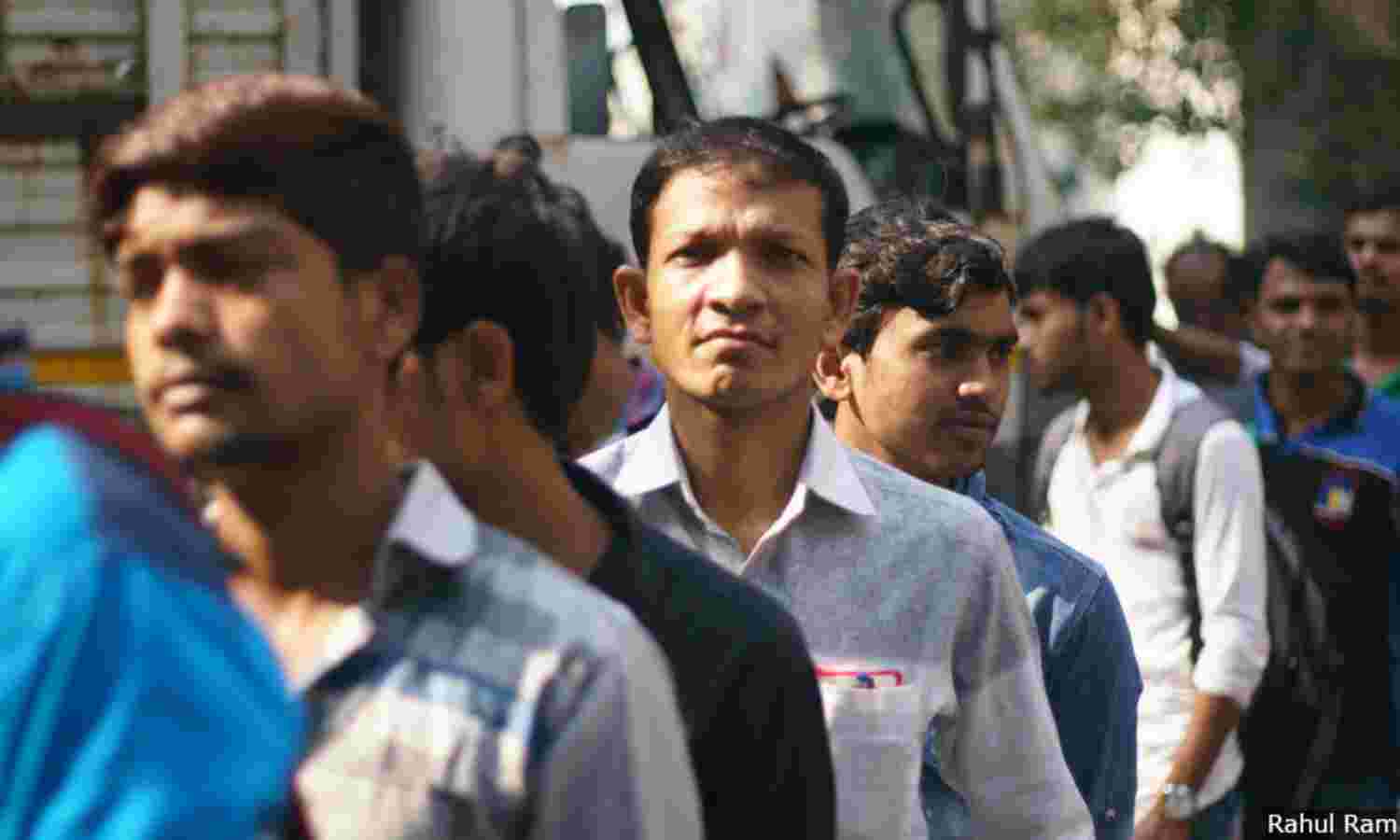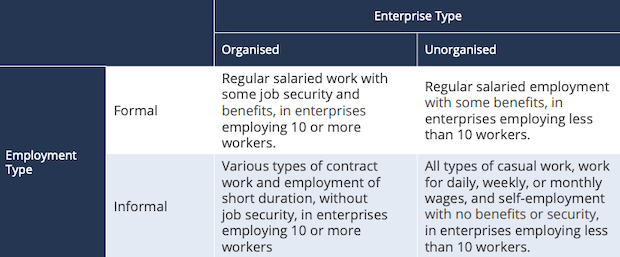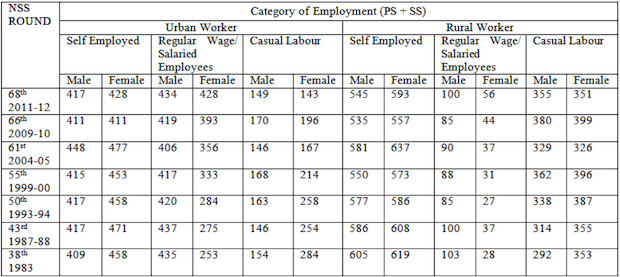90% Of Jobs Created Over Two Decades Post-Liberalisation Were Informal

Mumbai: Of around 61 million jobs created in India over 22 years post-liberalisation of the economy in 1991, 92% were informal jobs, according to an IndiaSpend analysis of National Sample Survey Office (NSSO) data for 2011-12, the latest available, released in 2014.
Liberalisation was expected to formalise India’s largely informal agrarian economy, with labour moving from agriculture--the largest employer--to the organised industrial sector. The formal and informal sectors are distinguished based on size of workplace and accompanying government regulations on working hours, hiring and firing norms, rights of association, minimum wages, and other aspects.
Liberalisation aimed to effect a decline in poverty and a rise in living standards through better wages and working conditions as labour moved toward formal jobs. Yet, in 2011-12, 51% of all jobs in the organised sector were informal, data show.
The number of informal sector workers increased from 341.28 million in 1999-2000 to 386.02 million in 2011-12, a 13% increase over 13 years. The number of formal workers increased by 81.5% from 20.46 million to 37.15 million in the same time period.
However, while formal workers comprised 6% of the total workforce in 1999-2000, this increased to just 9% in 2011-12, showing that the jobs that were created in the formal sector were mainly informal, employing workers with low earnings and with limited or no social protection.
Recent studies have confirmed that this trend has continued. A January 2019 report by Delhi-based economic policy think-tank ICRIER found that while total employment in the organised manufacturing sector had increased 78% to 13.7 million in 15 years to 2015-16, the share of contract workers in total employment had increased from 15.5% to 27.9%, and that of directly hired workers had fallen 10.8 percentage points to 50.4% in the same period, as IndiaSpend reported on March 28, 2019. At 8.3%, the average growth rate of contract employment was five percentage points more than that of regular employment.
Manufacturing companies are hiring more informal workers for short durations through contractors and fewer directly as permanent staff, as IndiaSpend reported on March 28, 2019, from the site of a labour-management dispute at a multinational manufacturers’ zone in Alwar, Rajasthan. Such workers get paid less, have poorer working conditions, and less job security, our investigation had found.
The International Labour Organization and the World Employment Federation have described predominance of informal employment as an indicator of lower quality of life, as workers in such jobs are vulnerable, without the social protections afforded to workers in formal jobs.
On the other hand, according to some economists, it is better to be employed and earn something than remain unemployed.
This story continues our investigation of the employment situation in India. Read other stories in our ongoing investigation here.
More informal jobs
Over half of informal sector workers in 2012 were self-employed, largely with a poor asset-base, and around 30% were casual labourers seeking daily wages, according to a University of Calcutta 2018 study of informal sector workers across India. About 18% of those employed were regular workers, and among them less than 8% had regular, full-time employment with social protection.
The 17th International Conference of Labour Statisticians held by the International Labour Organization in 2003 defines informal employment as those jobs where “…employment relation is, in law or in practice, not subject to national labour legislation, income taxation, social protection or entitlement to certain employment benefits (advance notice of dismissal, severance pay, paid annual or sick leave, etc.)”.

Source: Azim Premji University, State Of Working India, 2018
There can be informal work in the organised, formal sector and formal work in the unorganised, informal sector as well. Employment opportunities in the organised sector increased by 8.4% between 2004-05 and 2009-10, according to NSSO data, but the share of informal employment in this sector increased from 32% in 1999-2000 to 54% in 2004-05 and 67% in 2011-12.
That the phenomenon of increased workers in informal employment is on the rise in both the unorganised and organised sectors is confirmed by this study published in the International Organization of Scientific Research Journal of Business and Management in April 2018. The percentage of informal workers in the formal sector has increased from 38% in 1999 to 51% in 2011-12, the study said.

Sources: National Sample Survey, 1999-2011
While the services sector contributed most of the 61 million jobs created between 1991 and 2012, most of these remained informal in nature. Of 127.3 million people employed in the services sector in 2011-12, 80% were informal workers.
| Sector-Wise Breakup Of Informal Workers, 2004-2011 | ||||||
|---|---|---|---|---|---|---|
| Year/ Sector | Organised Sector | Unorganised Sector | Total | |||
| 2004-05 | ||||||
| Formal | Informal | Formal | Informal | Formal | Informal | |
| Agriculture | 0.2 | 4.1 | 0.1 | 264.2 | 0.3 | 268.2 |
| Manufacturing | 5 | 10.3 | 0.6 | 38 | 5.6 | 48.3 |
| Non-manufacturing | 2 | 7.2 | 0.1 | 20.1 | 2.1 | 27.3 |
| Services | 19.5 | 10 | 1.1 | 76.8 | 20.6 | 86.7 |
| Total | 26.7 | 31.5 | 1.9 | 399 | 28.6 | 430.5 |
| 2009-10 | ||||||
| Agriculture | 0.3 | 13 | 0 | 231.5 | 0.4 | 244.5 |
| Manufacturing | 5.3 | 11.1 | 0 | 33.9 | 5.7 | 45 |
| Non-manufacturing | 2.5 | 15.8 | 0.4 | 29.6 | 2.9 | 45.4 |
| Services | 22.7 | 13.5 | 1.4 | 78.7 | 24.1 | 92.2 |
| Total | 30.9 | 53.5 | 2.3 | 373.7 | 33.1 | 427.1 |
| 2011-12 | ||||||
| Agriculture | 0.5 | 17.7 | 0 | 213.6 | 0.6 | 231.3 |
| Manufacturing | 6 | 15 | 0 | 38.7 | 6.5 | 53.3 |
| Non-manufacturing | 3 | 20 | 0 | 32.7 | 2.9 | 52.3 |
| Services | 24.2 | 16.1 | 1 | 85.8 | 25.4 | 101.9 |
| Total | 34 | 68 | 2 | 370.8 | 35.4 | 438.9 |
Source: National Institute of Labour Economics Research, 2014
Note: Figures in million
While agriculture continues to provide the major share of employment, its share decreased from 58% in 2004-05 to 49% in 2011-12. Most of the employment here is informal in nature, with the informal workforce increasing.
The manufacturing sector’s share of total employment increased from 12% in 2004-05 to 13% in 2011-12.
The services sector also saw an increase from 107.3 million in 2004-05 to 127.3 million (19% increase) in 2011-12, but 80% of the jobs are informal.
More female workers in informal jobs
A gender-wise breakup of the informal workforce shows 252 million male and 118 million female workers in 1999-2000. This increased to 270 million male workers in 2009-10, but female workers decreased to 108 million during the same time period, NSSO data reveal. This is accompanied by a decline in regular salaried work for female workers and increase in self-employed, casual labour from 1983 to 2011-12.

Source: India’s Informal Employment in the Era of Globalization: Trend and Challenges, IOSR Journal Of Business Management, April 2018
Female informal workers are mainly engaged in agriculture , with some presence in manufacturing, trade, hotel, restaurants, community, social personal, services and construction.
At the all-India level, for the 68th round (2011-12) of the National Sample Survey, the proportion of self-employed workers was higher among females (51.2%, for both urban and rural) than among males (48%). Regular wage/salaried employees constituted a higher proportion of the urban workforce (43.6%) compared to rural areas.
It is also evident that the proportion of self-employment together with casual (informal) labour is higher among the rural female workforce (94.4%), compared to 57.1% among urban females, 56.1% among urban males and 90% among rural males.
Thus, even though overall employment and female labour force participation has increased since 1983, most jobs are informal, showing increasing “casualisation of the workforce”, the University of Calcutta 2018 study said.
The overall decline in casual employment and increase in regular employment of urban females is a promising development, according to a 2018 study by Charuchandra College, Kolkata.
The share of regular wage/salaried employees was merely 7.8% of the rural workforce, according to this study, while it was 56.8% in urban areas.
Self-employment together with casual labour had a share of nearly 92.2% of the total workforce in the rural areas.
Why informal jobs
The State of Working India 2018 study by Azim Premji University pointed to the lack of formal education and other barriers to entry in the formal sector as reasons for increase in informal workers in the organised services and manufacturing sectors.
In manufacturing, the increase in informalisation is due to two reasons, according to a 2018 study by the Indian Council for Research on International Economic Relations: first, because of dispersal of production from larger to smaller units; and second, because of the creation of an informal workforce subject to fewer regulations, the fact that employing contract (or informal) workers reduces the bargaining power of the regular or formal worker, suppressing wages overall.
Increased import competition has also led to informalisation of industrial labour as manufacturers seeks to improve their competitiveness by paying lower wages to informal workers and makings savings by forgoing expenditure on worker benefits, an Oxfam report from 2018 said.
(Salve is a senior analyst with IndiaSpend.)
We welcome feedback. Please write to respond@indiaspend.org. We reserve the right to edit responses for language and grammar.


